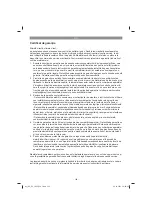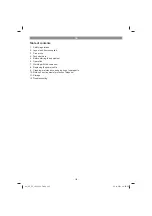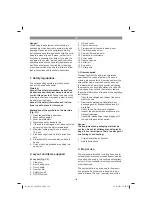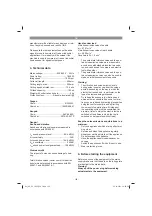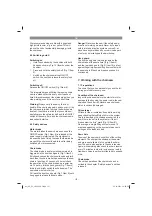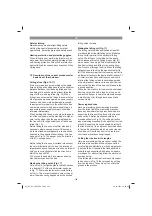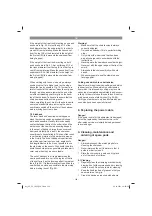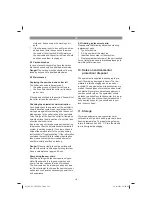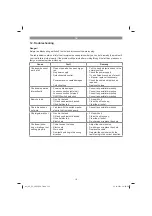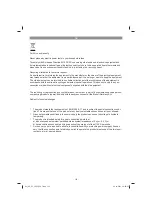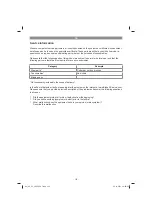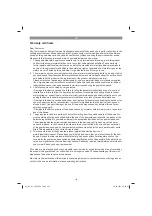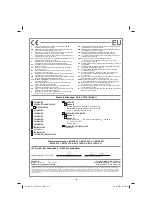
GB
- 108 -
Safety clothing
Always wear appropriate tight-
fi
tting safety
clothing like special trousers which protect
against cuts, protective gloves and safety shoes.
Hearing protection and protective goggles.
When felling trees or performing forest work, al-
ways wear a protective helmet with integral face
and hearing protection. This will o
ff
er protection
against falling branches and any branches if they
spring back.
7.2 Description of the correct procedures for
basic use of the chainsaw
Felling a tree (Figs. 14-17)
If two or more persons are working at the same
time on felling and cutting back then the minimum
distance between the tree being felled and the
tree being cut back should be at least twice the
height of the tree being felled (Fig. 14). When
felling trees, care must be taken to ensure that no
other persons are endangered, no power supply
lines are hit and no material damage is caused
to equipment or property. In the event that a tree
comes into contact with a power supply line, he
responsible power supply company should be
informed immediately.
When working with the saw on a slope, the opera-
tor of the chainsaw must be standing at a higher
point on the slope than the tree being felled, as
the tree will roll or slip downhill once it has been
felled (Fig. 15).
Before felling the tree you must
fi
rst plan and if
necessary clear an escape route. This escape
route must lead away diagonally in the opposite
direction to the expected fall direction – this can
be seen in Fig. 16 (A= danger zone, B= direction
of fall, C= escape zone).
Before felling the tree you must take into account
the natural inclination of the tree, the location of
larger branches and the wind direction, as this will
help you to correctly determine the direction in
which the tree will fall.
Dirt, stones, loose bark, nails, staples and wire
must be removed from the tree.
Making the felling notch (Fig. 17)
Cut a notch (A) at right angles to the fall direction
to a depth of 1/3 of the tree diameter as shown
in Fig. 17. First make the lower horizontal felling
notch (1). This prevents the saw chain or the gui-
de rail from becoming trapped when the second
felling notch is made.
Making the felling cut (Fig. 17)
The felling cut should be positioned at least 50
mm above the horizontal felling notch. Make the
felling cut (B) parallel to the horizontal felling
notch. The felling cut should be cut to a depth
which leaves a thin strip (felling hinge strip) (D)
which can act as a hinge. This strip prevents the
tree from rotating and falling in the wrong direc-
tion. Do not cut through the strip. When the felling
cut gets close to the strip the tree should start to
fall. If it becomes clear that the tree may well fall in
a di
ff
erent direction to the desired fall direction (C)
or it starts to lean back and traps the saw chain,
interrupt the felling cut and insert wedges made
of wood, plastic or aluminum to open out the cut
and control the lean of the tree until it leans in the
required direction.
When the tree starts to fall, remove the chainsaw
from the cut, switch it o
ff
, place it on the ground
and exit the danger zone via the planned escape
route. Watch out for falling branches and take
care not to trip.
Removing branches
Here we are talking about removing branches
from the felled tree. When removing branches,
leave any downward facing branches which are
supporting the tree until the trunk of the tree has
been cut up. Smaller branches should be re-
moved as shown in Fig. 18 (A= cutting direction
when removing branches, B= keep away from the
ground! Supporting branches should be left until
the trunk is cut up) in a single cut from the bottom
to the top. Any branches which are under tension
should be cut from the bottom to the top to pre-
vent the saw from becoming trapped.
Cutting the tree trunk into lengths
Here we are looking at the process of cutting the
felled tree into sections. Make sure you have a
sure footing and distribute your body weight even-
ly onto both feet. If possible the trunk should be
underlaid and supported with branches, beams
or wedges. For easy cutting follow the simple ins-
tructions below.
If the full length of the tree trunk is evenly suppor-
ted as shown in Fig. 19 then proceed by cutting
from the top down. Take care not to cut into the
ground in the process.
Anl_GC_EC_1835_SPK7.indb 108
20.10.2021 14:36:39
Summary of Contents for 4501714
Page 3: ... 3 4 5 7 8 6 B A 9 Anl_GC_EC_1835_SPK7 indb 3 20 10 2021 14 36 16 ...
Page 4: ... 4 11 12 13 14 15 10 B A Anl_GC_EC_1835_SPK7 indb 4 20 10 2021 14 36 17 ...
Page 6: ... 6 22 23 24 25 26 Anl_GC_EC_1835_SPK7 indb 6 20 10 2021 14 36 21 ...
Page 7: ... 7 27 1 2 3 4 5 6 7 8 9 Anl_GC_EC_1835_SPK7 indb 7 20 10 2021 14 36 21 ...
Page 116: ...EH 10 2021 01 Anl_GC_EC_1835_SPK7 indb 116 20 10 2021 14 36 40 ...









